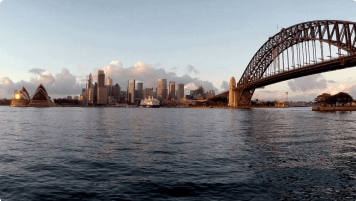The Australian Outback: A Definitive Guide
Explore learn and consider what is the outback in this article. For mature and senior travelers considering joining a small group package tours into the outback to see, learn and explore about this unique place, not only the landscape but the Aboriginal approach to living. On each of the tours for couples and the single traveler you learn something different but fascinating, from Outback Queensland, the Flinders, Broken Hill and the Kimberley and the wildflowers all contribute to this question, what is the outback?
18 Jun 20 · 15 mins read
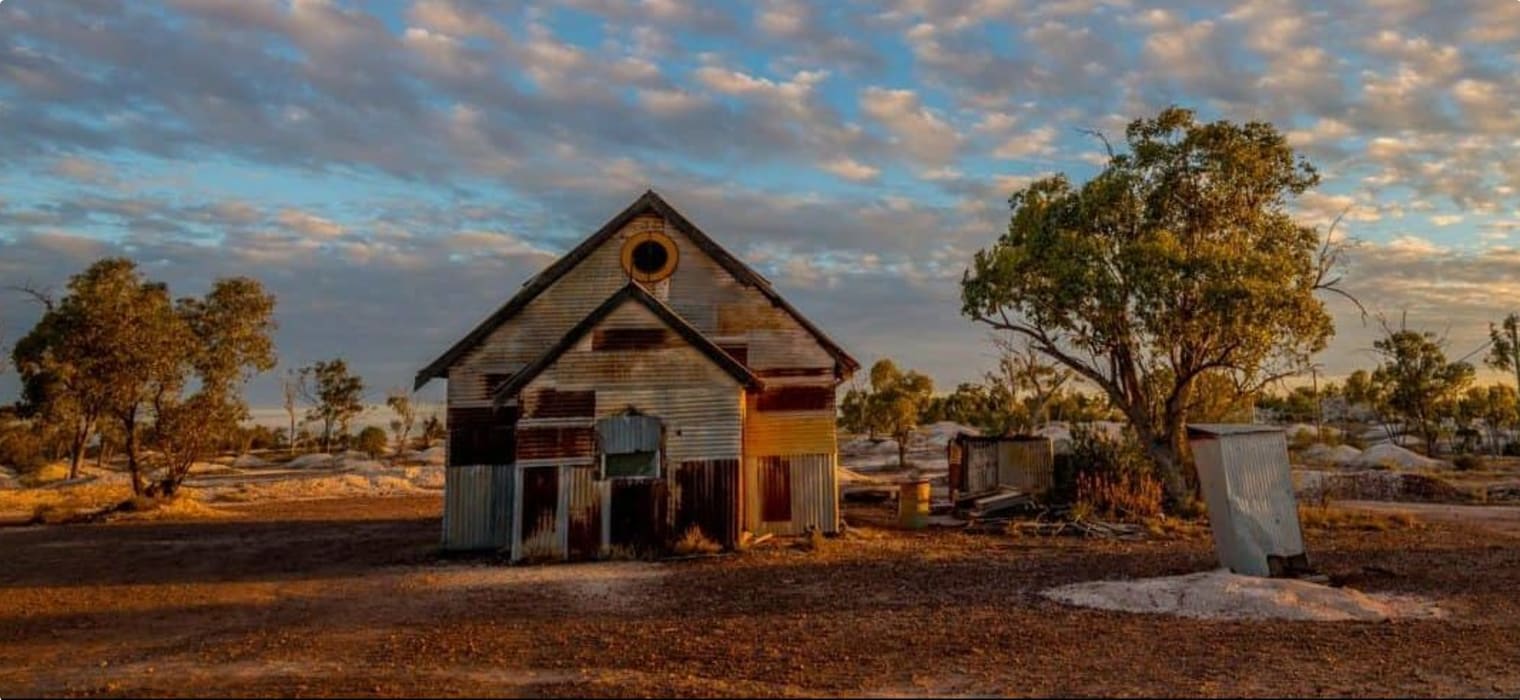
The Australian Outback: A Definitive Guide
‘Back o’ Bourke’, ‘beyond the black stump’, ‘Outback’, ‘Never Never’: the various names given to the vast inland of Australia reveal just how hard it is to precisely summarise what exactly the Outback is, even as it defines Australia’s sense of self and international image.
The Outback is not a place with a definite boundary, but a ‘state of mind’: referring to the most remote part of the country, where the landscape seems to stretch forever in every direction and the nearest property might be days away, let alone the nearest town. It is a place defined by a strange and harsh beauty, that exercises a strange hold over our imaginations.
This article aims to introduce readers to the history, geography and culture of the Outback, to provide background information for Odyssey Traveller’s Outback and other Australia tours.
What is the Outback?
The concept of the Outback goes back to the 19th century idea of ‘back’ country, which was in use by 1800 to describe land beyond the settled regions. The crossing of the Blue Mountains gave a new sense of the scope of the Australian continent, and the term ‘outback‘ was born. ‘Outback‘ was first used in print in 1869, when the writer was referring to lands west of Wagga Wagga, New South Wales.
If you’re Australian, you’ve probably heard people say that the Outback is ‘beyond the black stump’. But where exactly is the black stump? It has been suggested that the ‘black stump’ refers to the Black Stump Wine Saloon, which stood about 10 kilometres out of the town of Coolah, NSW. Others suggest that the ‘black stump’ refers to a fire-blackened tree stump used by surveyors near Blackall, QLD, in 1887 (Mayne, Beyond the Black Stump, 4). Either way, the term entered the Australian vernacular – and now the location of the ‘black stump’ varies according to local folklore. In Nevil Shute’s Beyond the Black Stump (1956), a novel set in north-western Australia, a visiting American asks what precisely the ‘black stump’ is. The Australian explains that ‘it’s just what they say around here. It just means – anywhere.’
Even today the precise definition of ‘outback’ remains a point of contention. The Australian Department of Agriculture, Water, and the Environment defines ‘rangelands‘ (as they term the Outback) as covering 81% of Australia‘s landmass, including all of the Northern Territory; Queensland from Cape York to Birdsville, with the border heading inland north of Mackay (and not including areas around Cairns and Townsville); Western New South Wales, beginning east of Bourke; Northern South Australia, beginning just south of Port Augusta, and most of Western Australia, except for a south-western band stretching from east of Esperance to south of Canarvon. Out of Australia‘s states, only Victoria and Tasmania do not include areas of Outback.
Others contest this definition, particularly the inclusion of the tropical – and wet – Top End, Kakadu National Park, Arnhem Land and Cape York. They define the Outback as the arid and semi-arid regions of Australia, where red dirt predominates. This definition still includes over 70% of the Australian continent.
By contrast, over 90% of Australia’s population live on the fertile coastal plains of the east, south-east, and south-west. Though many urban Australians have a vision of the Outback as arid, empty and monotonous, it comprises a number of distinct cultural and geographic regions.
Regions of the Outback:
The Central Deserts:
Australia‘s red centre is the arid heart of the Outback. It is home to Australia‘s ten deserts, and some of the most iconic Outback landmarks, including Uluru, Coober Pedy, and Kata Tjuta.
We have defined the Central Deserts as stretching north-south from Marree (just south of Lake Eyre) to the ghost town of Newcastle Waters (between Tennant Creek and Katherine), where the ‘Top End’ begins. East-west it spans from the South Australia/New South Wales border to Wiluna, Western Australia.

This area is home to all of Australia‘s deserts. The Great Victoria Desert, stretching from South Australia into Western Australia, is Australia‘s biggest desert. Most sources estimate it at around 424,400 km squared, making it the world’s third largest desert after the Sahara and the Arabian Desert.
Other significant deserts include the Simpson Desert, which is defined by a remarkable system of parallel dunes, which rise as high as 40 metres, and stretch (without break) for 200 metres. The smaller Sturt Stony Desert is notable for its extreme dryness; which proved an obstacle to the explorer Charles Sturt (after whom the desert is named) on his quest to find the ‘Inland Sea’. Sturt recalled that the land was covered in stones ‘so thick on the ground, that it was impossible for any herb to have forced its way between them.’
Compared with other deserts internationally, Australia‘s deserts receive relatively high rates of rainfall. No weather station in Australia records less than 100mm of rain annually. As a result, all of Australia‘s deserts are coverfed with flora, particularly mulga and spinifex. Australia‘s deserts are home to a number of endemic animals, including mammals, birds, reptiles, frogs and insects. In particular, Australia‘s deserts are marked for their reptile community, with over 210 species living in arid areas – including Acanthophis pyrrhus, the infamous desert death adder snake.
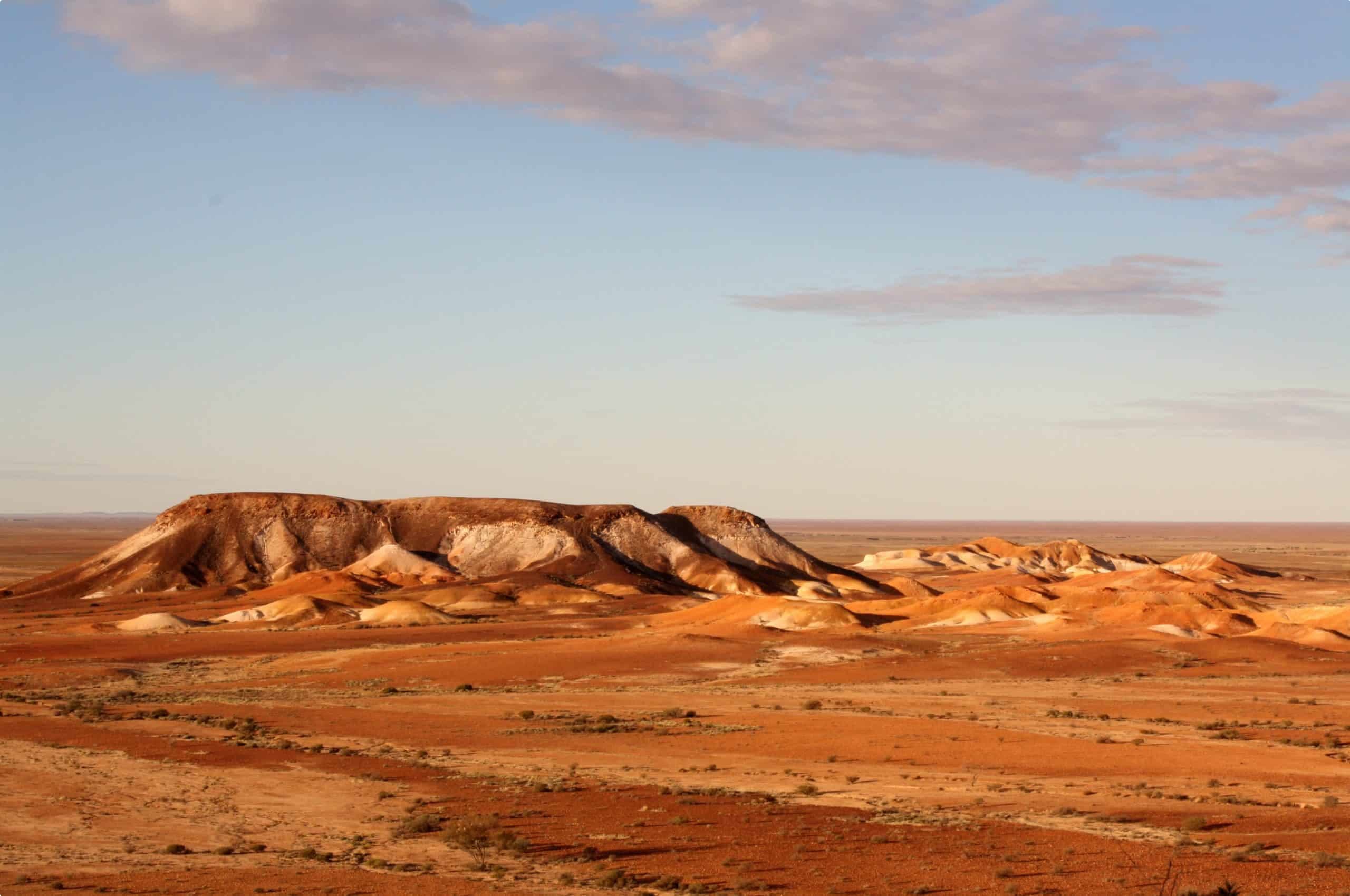
Farming here is limited to very low-intensity sheep and cattle production. A number of famous trails, allowing for (relatively) safe passage through the desert, were developed in the 19th century. The Oodnadatta Track follows an ancient Aboriginal trade route, later used by John McDouall Stuart in his explorations of the centre of Australia, which in turn provided the route for the telegraph cable from Port Augusta to Darwin. The Birdsville Track allowed Queensland graziers to transport their cattle to Marree, and then by train to Adelaide, rather than make the lengthy trip to Brisbane. Today these routes represent the ultimate Outback adventure, doable only by 4WD.
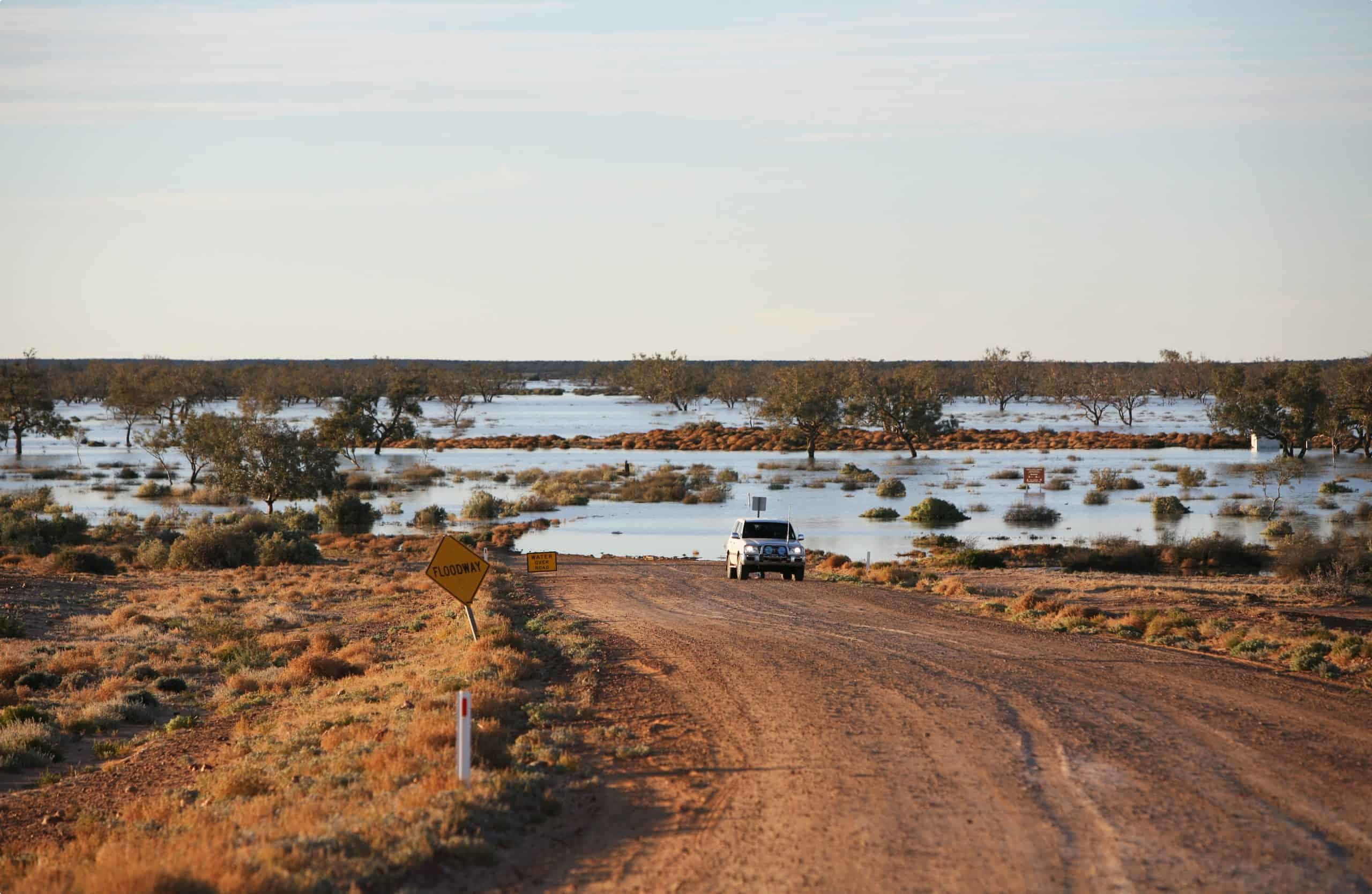
The South:
South of the central deserts, this area of the ‘Outback‘ – extending from western New South Wales through South Australia, to the south-west of Western Australia – is less quintessential, more populated and (mostly) less arid.
Much of this area is pastoral country, with huge properties – mostly sheep stations – taking up vast areas. Distances between towns are less vast than they are in other parts of the Outback, but still nothing to sneer at.
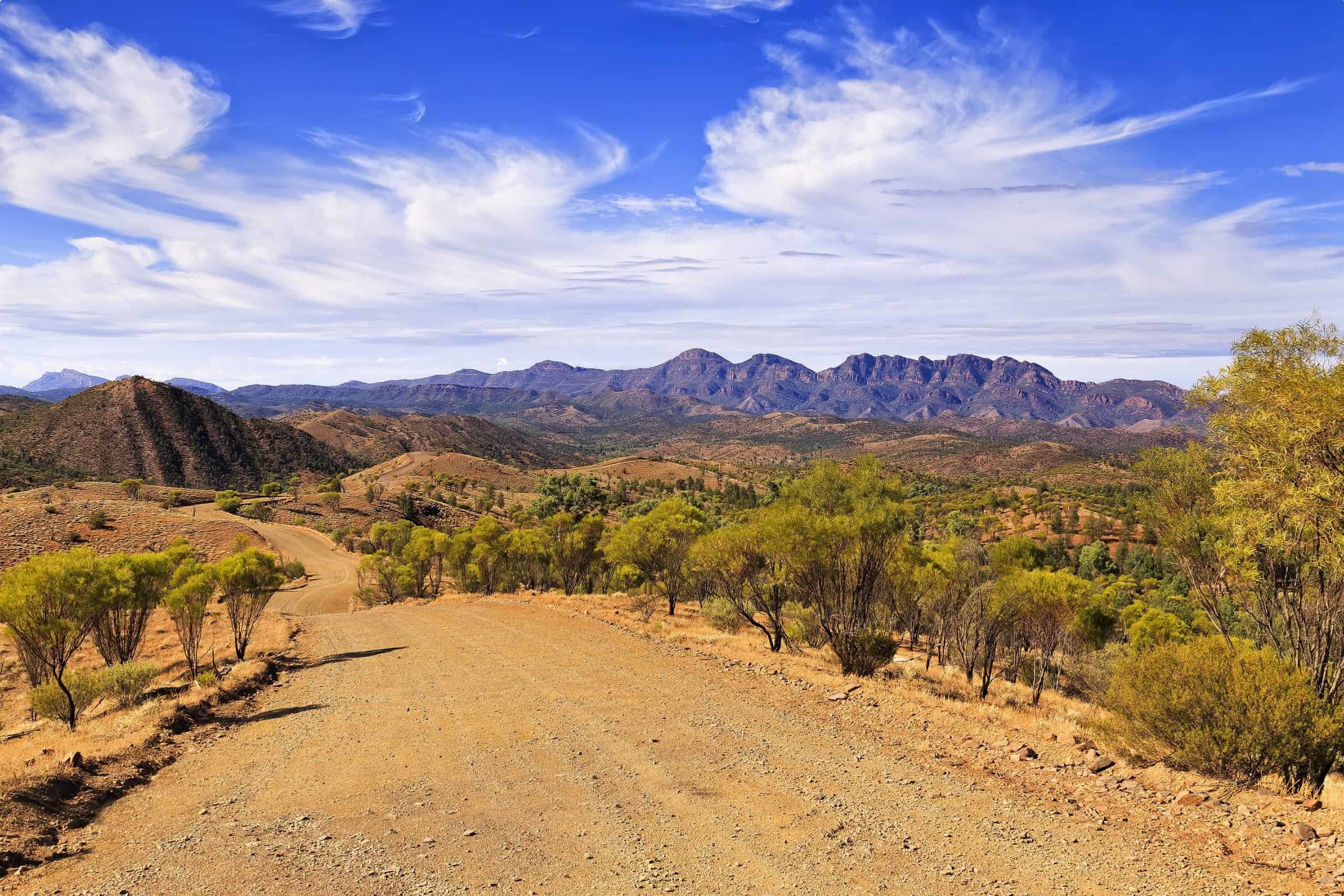
This area also includes the infamous Nullabor Plain (latin for ‘No tree’), the world’s largest limestone karst plateau, stretching along the southern coast of Australia. Here sheer cliffs plunge the Outback directly into the sea. The first European to reach the area, explorer Edward John Eyre, described it as ‘the sort of place one gets into in bad dreams’, a virtually featureless flat savannah stretching for over 2000 kilometres. Underneath the plain, however, is a vast network of extraordinary limestone caves.
The ‘South’ is also home to the stunning landscapes of Wilpena Pound and the Flinders Ranges, South Australia; the quirky ‘silver city’, Broken Hill, and the UNESCO World Heritage Listed Willandra Lakes, where Mungo Man and Mungo Lady, the 40,000 year old burial remains of two people were found by geologist Jim Bowler, transforming our understanding of Aboriginal history.
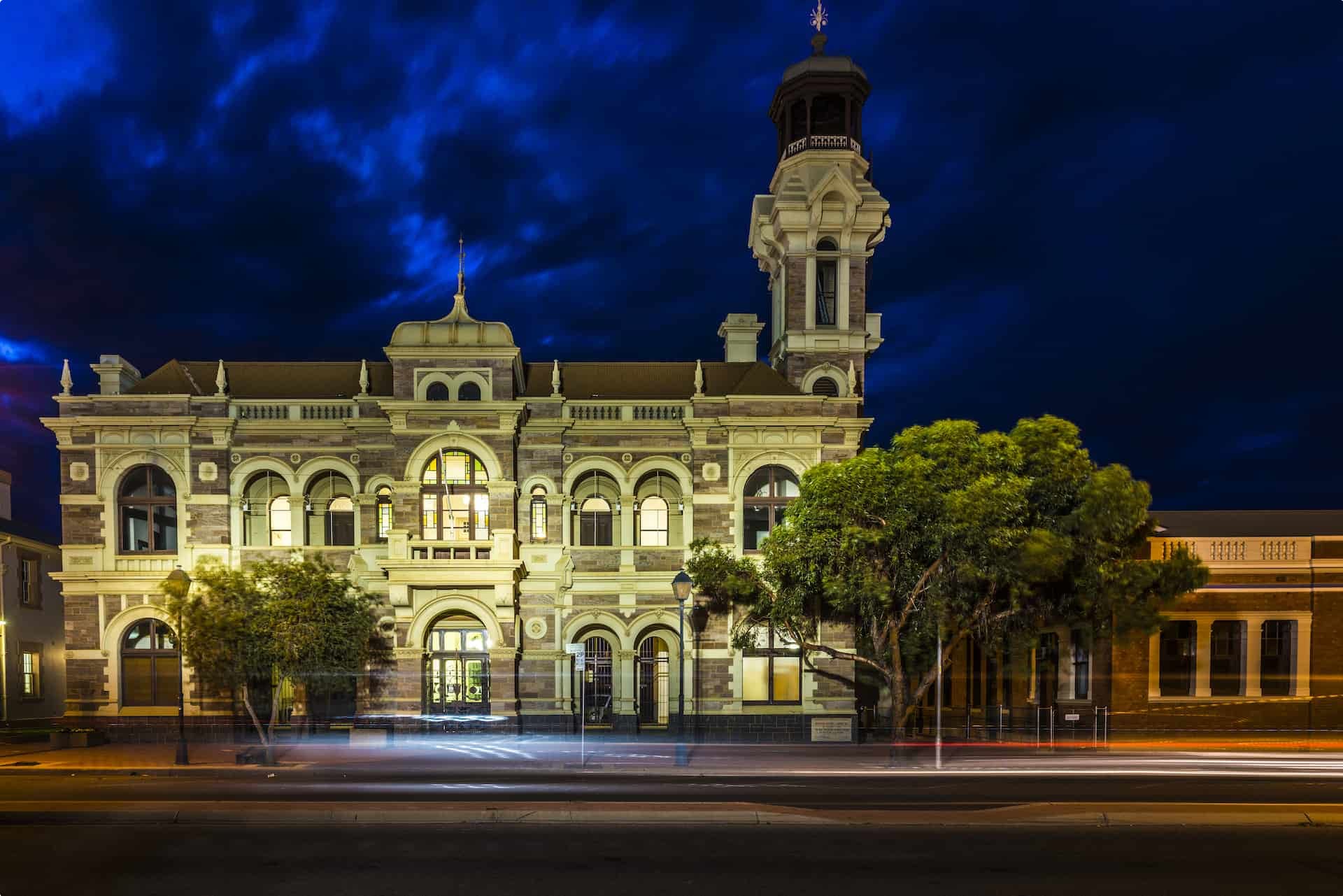
The North-West:
Home to the stunning landscapes of the Kimberley and the rugged Pilbara, the ‘north-west’ Outback might be the most remote area of Australia. Less than 30,000 people live in the Kimberley, a region the size of Victoria and Tasmania combined, while the population of the Pilbara is only slightly larger, around 45, 000. Towns are few and far between here (with the exception of Broome), mostly old mining towns such as Halls Creek in the Kimberley, and fly-in fly-out settlements in the Pilbara.
The area is so remote that the striking Bungle Bungles of Purnululu National Park were only discovered in 1982, thanks to a film crew passing over from the air.
Unlike the drier regions further south, the Kimberley has a wet season, which transforms the dry, red sand landscape into something lush and verdant, as the area’s many river gorges spring to life.
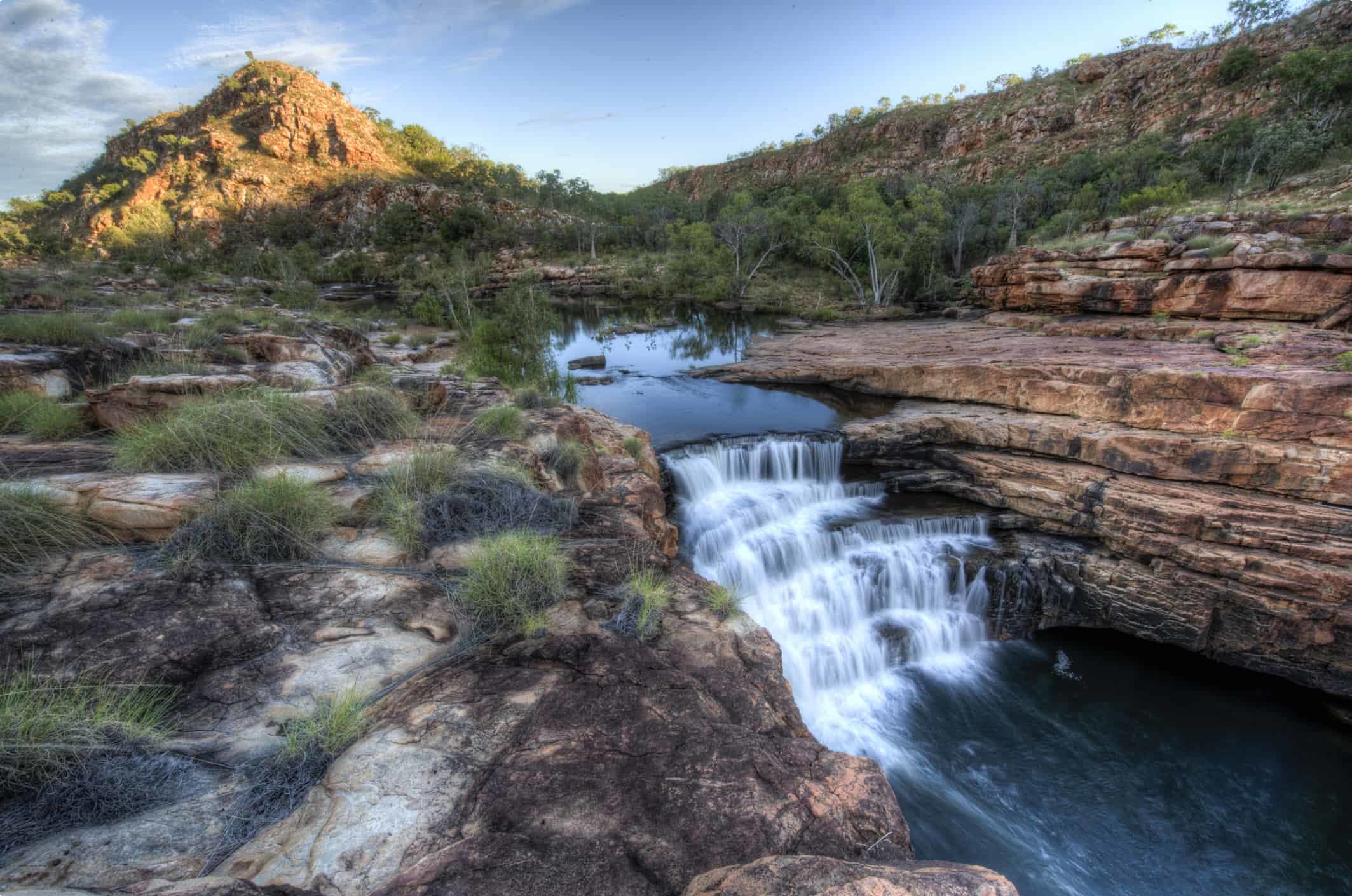
The Tropics:
Many argue that the tropical regions of Kakadu National Park, Arnhem Land and Cape York are too lush to be considered part of the real Outback. But nobody can deny that this region includes some of the most iconic Outback territory. The cattle areas of Outback Queensland gave birth to the archetype of the Australian stockman, mythologised in the Outback poetry of Banjo Paterson and Henry Lawson.
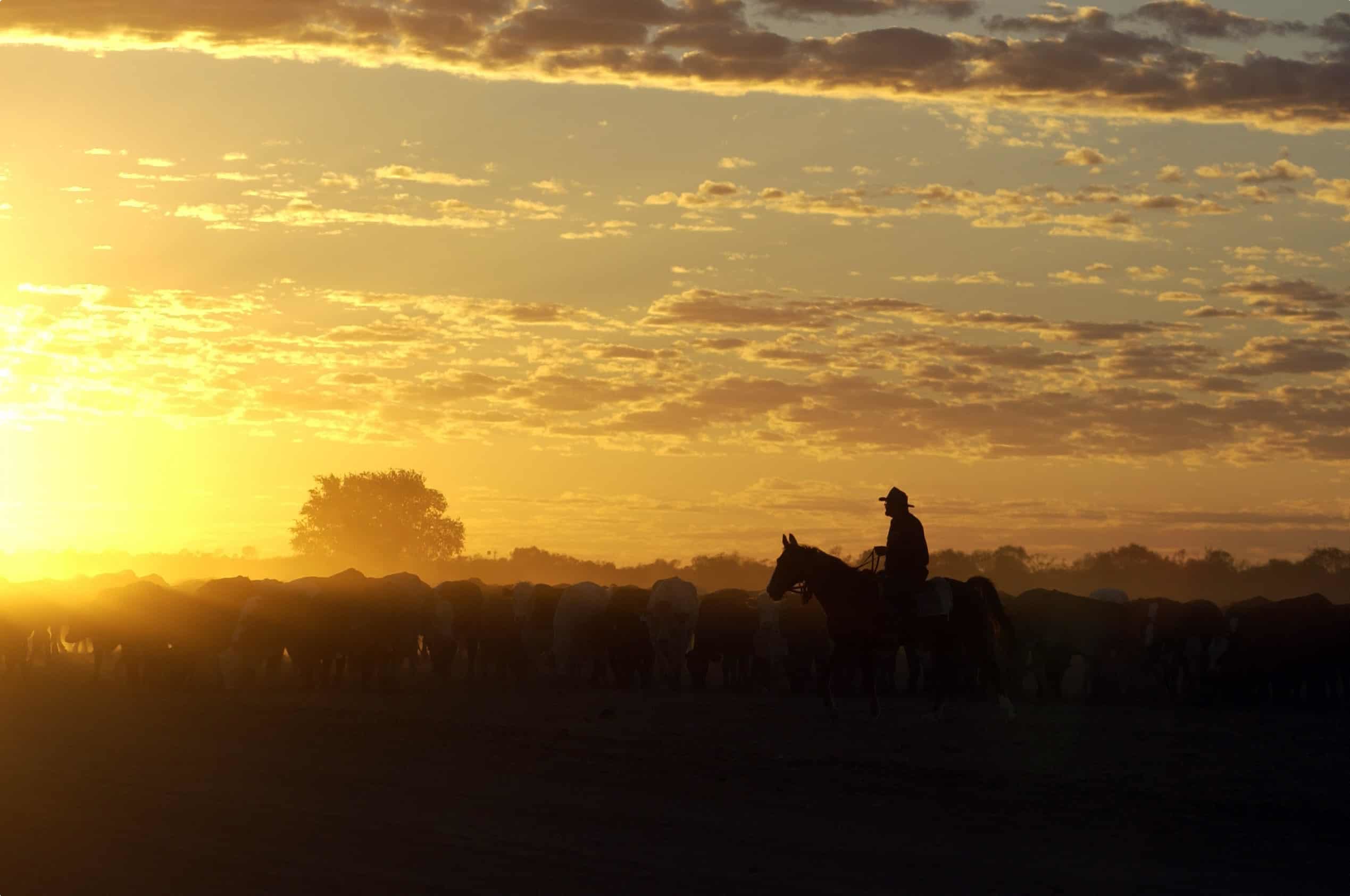
Other interesting sites here include Winton (where Waltzing Matilda was written), the nearby dinosaur remains at Lark Quarry Conservation Park, and Barcaldine, the birthplace of the Australian labour movement.
Geology of the Outback:
The Outback is shaped by ancient geological processes. Along with Africa, South America, Antarctica and India, Australia once formed part of the supercontinent Gondwana. Virtually all of the Outback is part of a huge crustal block known as the Australian Craton. The craton is geologically ancient, with metamorphic and igneous rock ranging from 570 million to 3.7 billion years old. The most ancient rock formations, in the Pilbara, formed 4.3 billion years ago, making them part of the earth’s original crust. The world’s oldest known lifeforms, stromatolites (3.5 billion years old), are also found in the Pilbara.
Though more recent geological shifts have occurred – most notably, the emergence of the Flinders Ranges around 500 million years ago – the Outback has remained remarkably stable, perhaps explaining why so much of the territory is flat.
Though the Outback is arid it is virtually never without vegetation. The tropics are largely covered with forest, and (as we have seen), even the deserts have some flora.
Perhaps owing to the ancient geological history of the Outback, plants have evolved to cope with the harsh conditions. Flora commonly found in the Outback includes eucalypts, wattle, spinifex, grass trees, salt bush, desert oak, and boabs (endemic only to the Kimberley). In spring the landscape, particularly in Western Australia, explodes with colourful wildflowers.
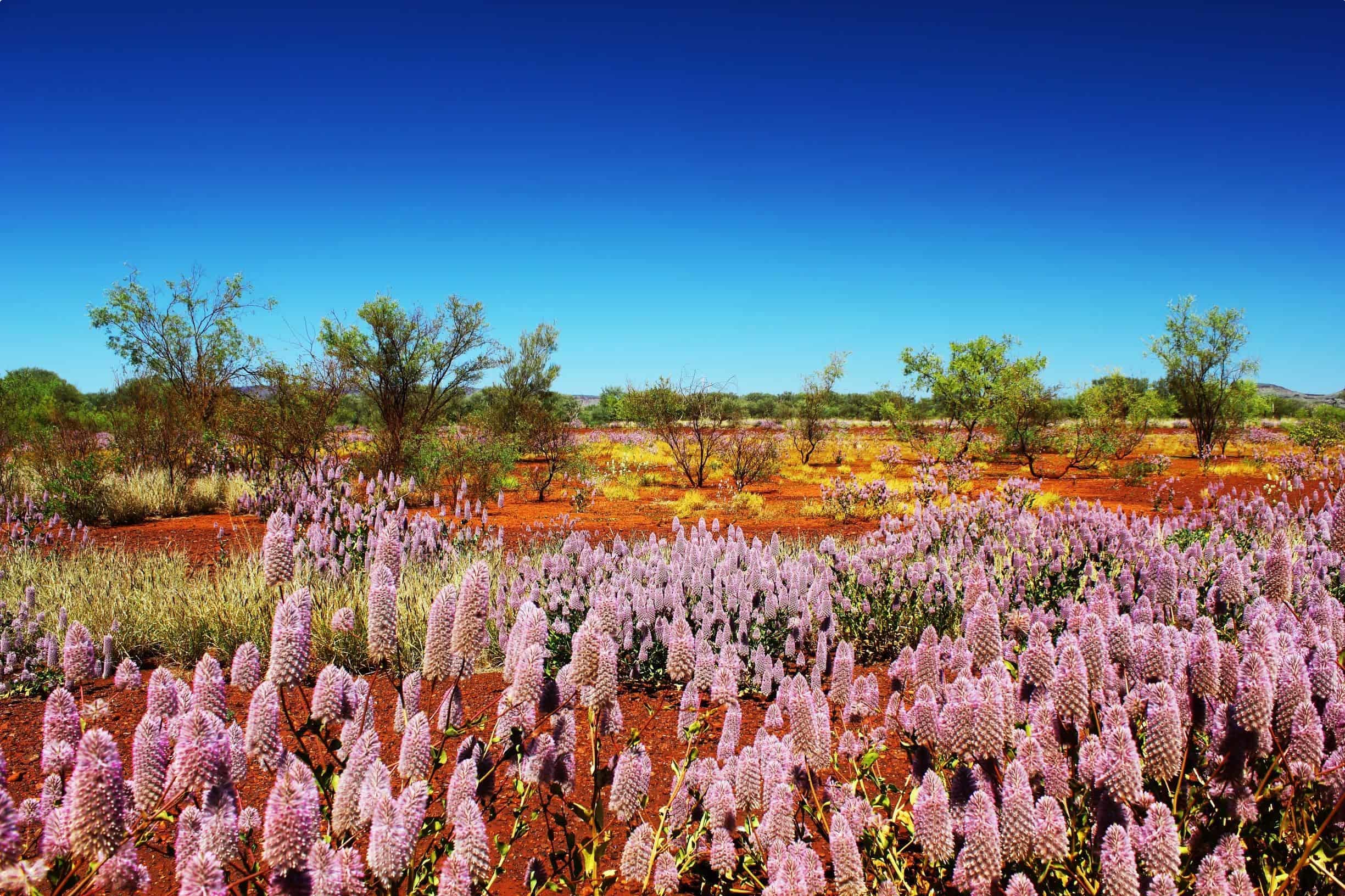
Aboriginal peoples of the Outback:
The first peoples to arrive in Australia likely came through the Kimberley. In Carpenters Gap in the Kimberley, the world’s oldest ground-edge axe – 44,000 to 49,000 years old- was discovered by archaeologists. However, indications are – given that Mungo Man and Mungo Lady, found on the opposite side of the continent, date back more than 40, 000 years – that settlement in the Kimberley was much earlier, between 50, 000 and 120, 000 years ago.
When the first peoples arrived in Australia, they encountered a continent vastly different than today. During the Ice Age, the coast was kilometres from where it is today, and mainland Australia and Tasmania were connected across what is now the Bass Strait. The arid centre was more fertile – the dry lakes where Mungo Man and Mungo Lady, were, in the times in which they lived, fertile, while the cooler regions of Australia, Tasmania and the Australian Alps, were inhospitable. The rising of the seas at the end of the Ice Age – 17,000 years ago – forced people to retreat from coastal areas in favour of inland territories, transforming the way that Australia‘s first peoples lived.
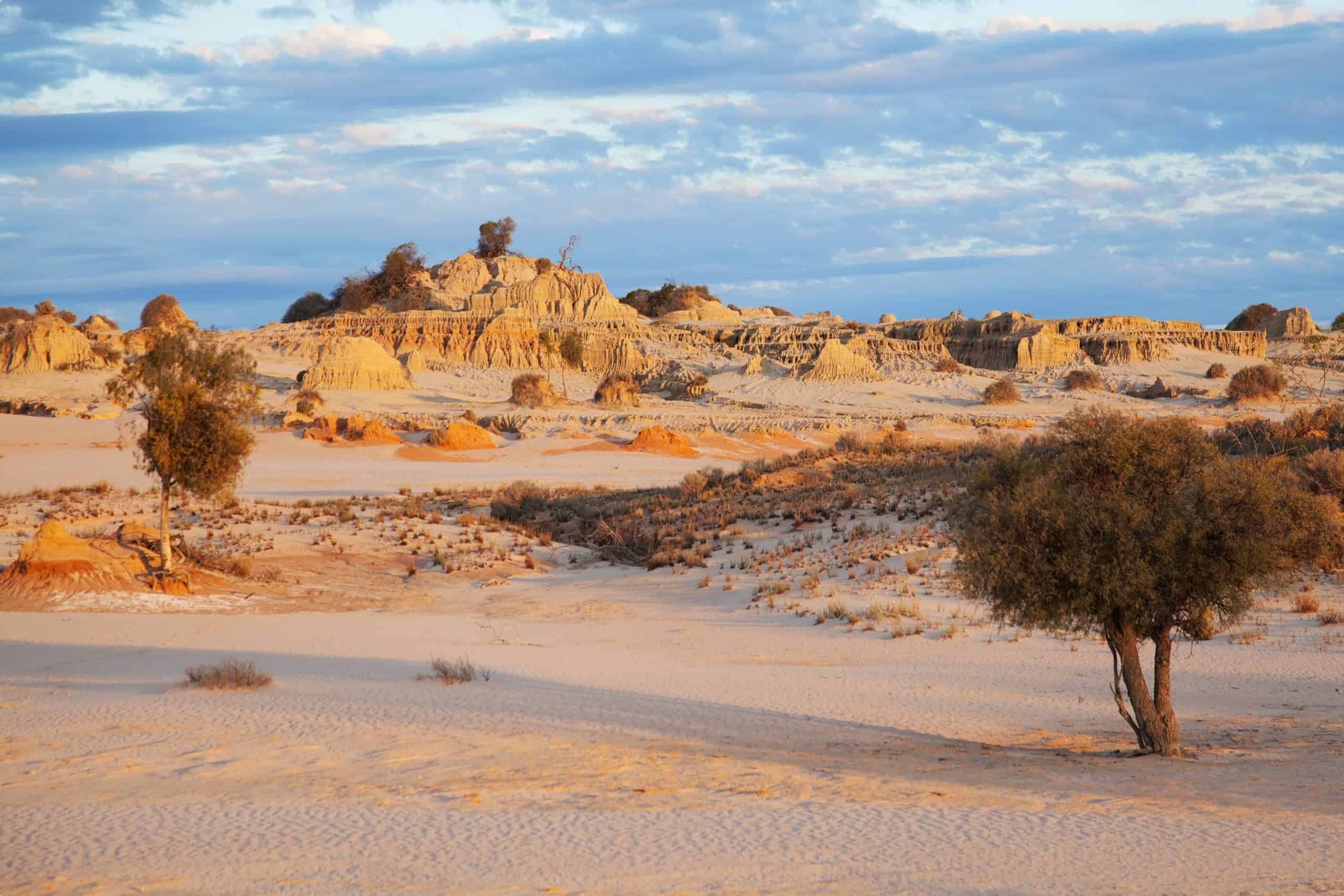
The lifestyles of Aboriginal peoples living in the deserts differed from those in more fertile inland areas or by the coast. In well-watered country – such as lands along the Murray River – tribal lands were compact, but in the inland deserts they were vast, with some tribal areas larger than Ireland (Blainey, 31). Desert peoples covered vast tracts of land, spreading out after rain, and retreating to permanent waterholes during drought.
While the Australian Outback is often seen as a desolate space, unfit for habitation, Aboriginal peoples lived successfully in arid areas for thousands of years. Early explorers often commented on the healthy, tall, and ‘well built’ people that they met, even in arid lands.
Aboriginal peoples of the desert were able to survive by locating permanent waterholes and wells, and by understanding the erratic water patterns of salt lakes, swamps and clay pans. The roots of mallee and wattles could yield water, which was drained into dishes and bags.
In the desert, Aboriginal people foraged for insects, birds, reptiles and mammals, and collected seeds – which were ground and baked with water to make damper. Near the border of Queensland and South Australia, local people hoarded the seeds of portulac, with a granary containing around 45 kilograms of seeds discovered by explorers near Lake Lipson. It was concealed by an inner wrapping of grass and an outer wrapping of clay.
Wild fruit trees were commonly found by explorers in the desert. W.C. Gosse recalled that, on the expedition on which he was the first European to sight Uluru, he encountered a dry creek vivid with the fruit of the quandong, which he boiled into a sweet jam. In Central Australia, at least thirty forms of fruit were known to local peoples. In the Western Desert, fruits were preserved, pounded into reddish-brown paste and then dried in the sun.
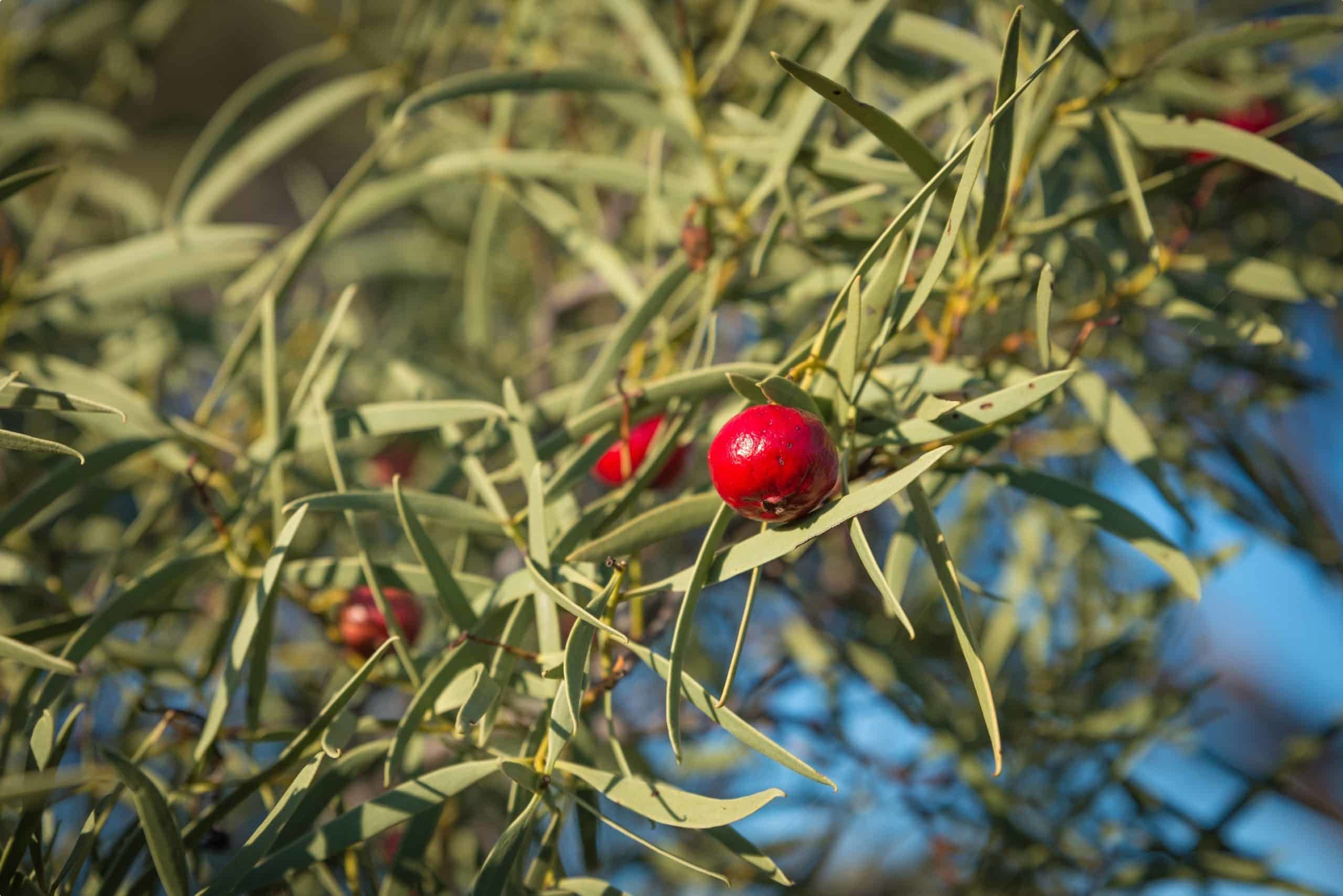
Aboriginal peoples made use of fire for a number of purposes. Carrying fire sticks kept desert peoples warm on cold winter nights, while sending smoke signals to communicate with others in the distance. Fire was also used to control the environment and promote the growth of edible plants. Out of twelve food plants that grow in central Australia, five need fire to survive, while three tolerate it and four are killed by it. In 1788, all twelve thrived, so local peoples would have tended to each according to the needs of each plant (Gammage, 14). Late 19th century photos of Uluru show the rock surrounded by strips of grass, indicating a managed use of fire to maintain the environment – as fire too frequent lets in spinifex; too infrequent, scrub.
Before the arrival of Europeans, there were around 250 Aboriginal languages, comprising around 700 dialects. Linguists believe that these evolved from a single language root, becoming mutually intelligible as Aboriginal peoples spread across the continent. Most Aboriginal languages have around 10, 000 words – the same amount used by the average speaker of English.
Culturally, there were over 500 first nations at the time of settlement. Though they shared some cultural elements – particularly that of the Dreaming, or Dreamtime, tied to a deep connection with the land – these were refracted through local traditions and beliefs. In the desert, the harsh landscape necessitated sharing country, knowledge, and resources with other groups.
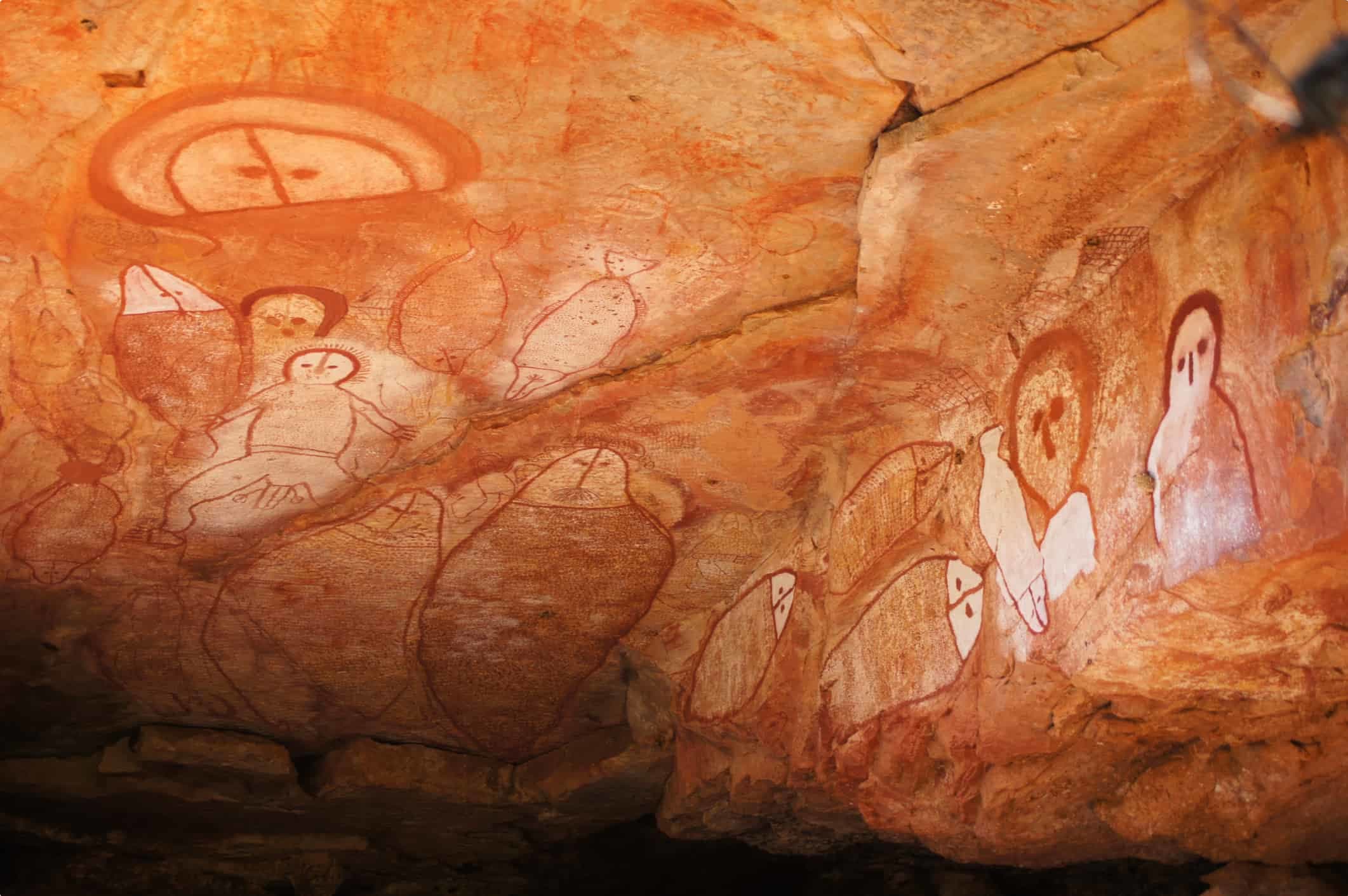
Some of the most vivid testaments of pre-settlement Aboriginal lives come from the rock art which dots the Australian Outback. In the Kimberley, the Gwion Gwion paintings (often known as ‘Bradshaws’) depict elegant, elongated peoples, elaborately dressed with accessories of bags and headdresses; while the later Wandjina depict round heads, huge eyes without a mouth. Carpenters Gap in the Kimberley is home to some of the oldest evidence of rock painting, an ochre-stained palette dating back 40,000 years. In the sandstone Arnhem Land plateau, rock art galleries date back 18,000 years. Important Aboriginal art can also be seen in the Flinders Ranges, and in Canarvon Gorge, Queensland.
Other art forms include Western desert painting, also known as ‘dot painting’, which evolved from ‘ground paintings’, which formed the centrepieces of dances and songs. Paint was made from pulped plant material, and designs made on the ground using dots. This was translated into the dot paintings we see today – which, though seemingly abstract to the Western eye – often depict Dreaming stories, identifying ancestral beings, birds, animals and humans.
Exploration of the Outback:
The first Europeans to head into the vast Outback were the explorers of the 19th century, who charted the Australian continent. In 1813, Gregory Blaxland, William Lawson, and William C Wentworth crossed the Blue Mountains, opening up inland Australia to exploration and settlement. In subsequent decades Hamilton Hume, John Oxley, William Hovell, Charles Sturt and Thomas Mitchell charted the lands around the Murray-Darling River System, opening the countryside between Sydney and the new settlements of Melbourne and Adelaide.
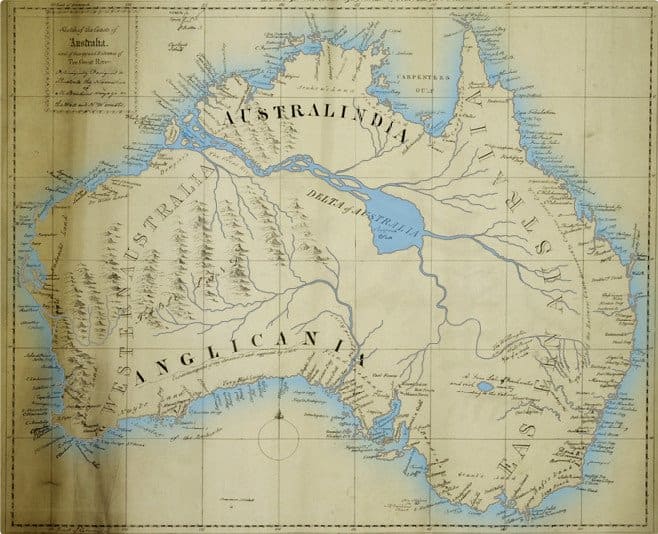
The first exploration party to reach the Outback was a group led by Charles Grey, who landed on the Kimberley coast in 1838, barely keeping their lives in what they saw as a forbidding terrain.
Successive generations of explorers headed into the centre of Australia, with the aim of discovering what they believed would be an inland sea. This faith was given evidence by the westward-flowing rivers of New South Wales, though in 1829-30 Charles Sturt solved the riddle when he charted the Murray-Darling Rivers. Despite this, Sturt still adamantly believed that there was an inland sea, and that he had been ordained by God to find it. In 1844, he set out from Adelaide to find it, following the Darling River and then striking west. Dealing with extreme heat and lack of water, Sturt and his men spent months at Depot Glen, near present-day Milparinka, before passing on to Eyre Creek, north of Birdsville. Though only one man died on this 18-month journey, Sturt’s health never recovered and he remained depressed by his inability to find the promised sea.
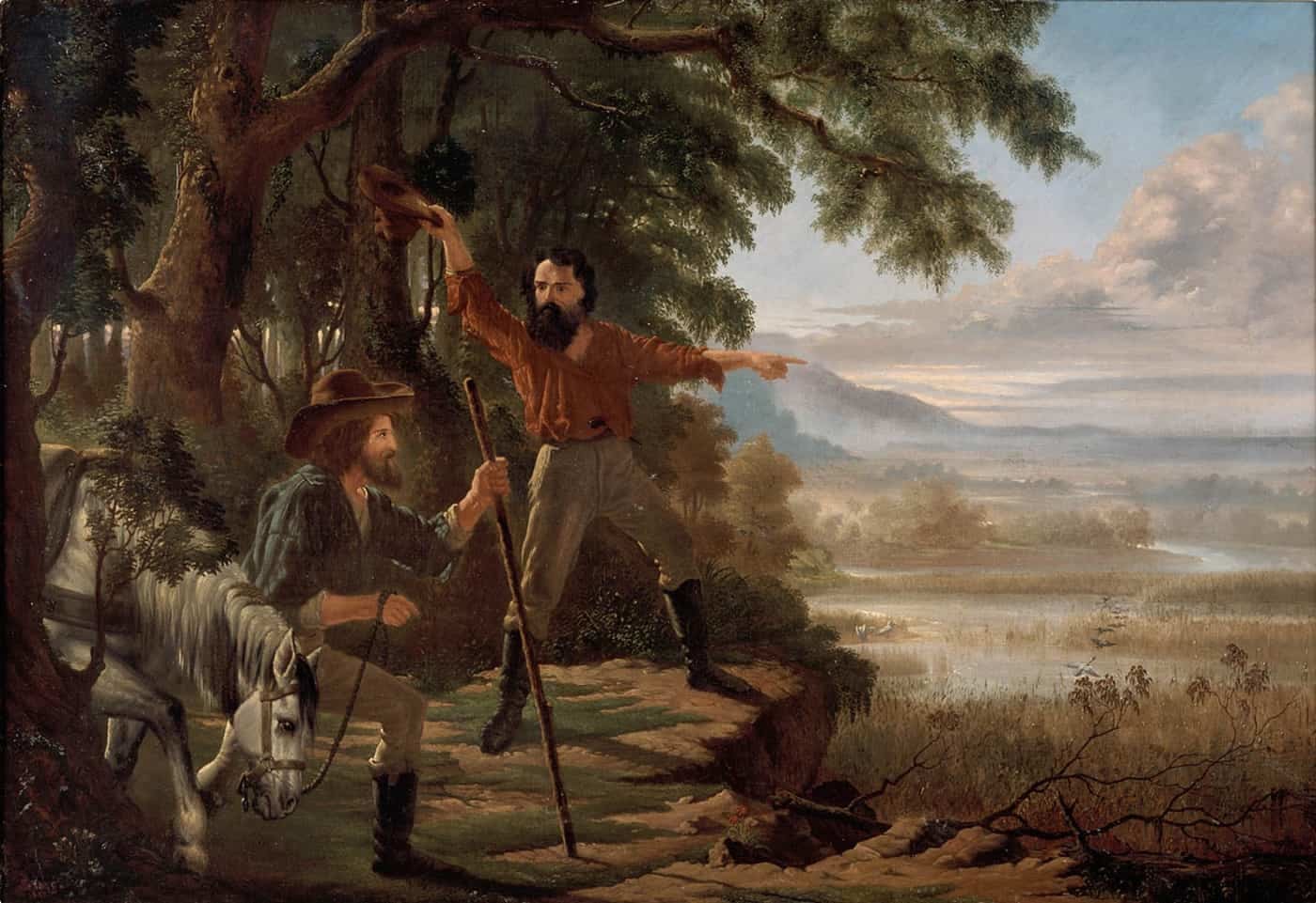
The inland would be further explored by Burke and Wills and by John McDouall Stuart, who – funded by Victoria and South Australia respectively – were in competition to cross the Australian continent. Burke and Wills almost made it – reaching a sound from which the Gulf of Carpentaria was visible – before meeting their deaths on their return route; Stuart successfully reached Chambers Bay, east of Darwin, and returned to Adelaide, creating the route for the Overland Telegraph Line.
The disappearance of Burke and Wills saw rescue teams from South Australia, Queensland, and Victoria criss-cross the continent, many of whom were rather more adept at exploring than the doomed Burke and Wills.
From the 1890s, the emphasis shifted towards scientific and anthropological expeditions, designed to look for minerals, study Australia’s unique flora and fauna, and to learn about Aboriginal peoples who still lived according to traditional ways.
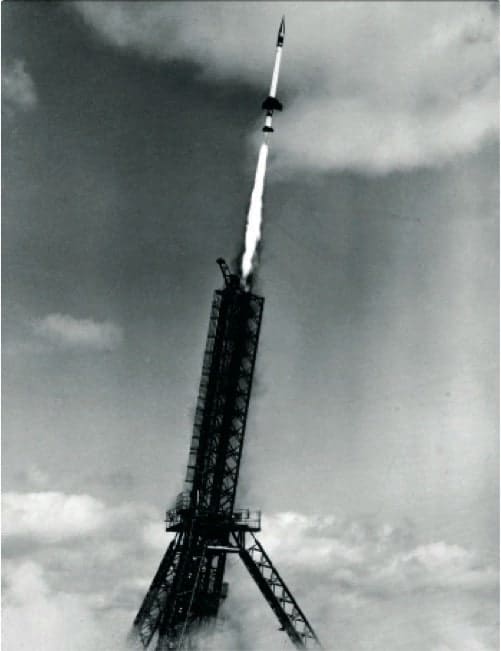
The end of the era of exploration was marked in the 1950s, when surveyor Len Beadell opened up swathes of the South Australian, Western Australian and Northern Territory deserts to establish the atomic-bomb test sites of Emu Junction and Maralinga, and the Woomera Rocket Range.
The Outback in Australian culture:
In a 1996 documentary, George Miller, director of the Mad Max films suggested that white Australian filmmakers used cinema to spirit their country into being in the way that Aboriginal creation myths had done before white settlement. The mythology of the Outback, created by writers and filmakers, has created a distinct image for modern Australia, that defines Australia to ourselves and the world.
The modern image of the Outback was first created by the bush balladeers of the late 19th and early 20th centuries. The two most successful balladeers were AB ‘Banjo’ Paterson and Henry Lawson. Paterson grew up in the bush in the second half of the 19th century, and wrote about station life with a great sense of optimism. His most famous works are Clancy of the Overflow, The Man from Snowy River, and Waltzing Matilda, Australia’s ‘alternative national anthem’.
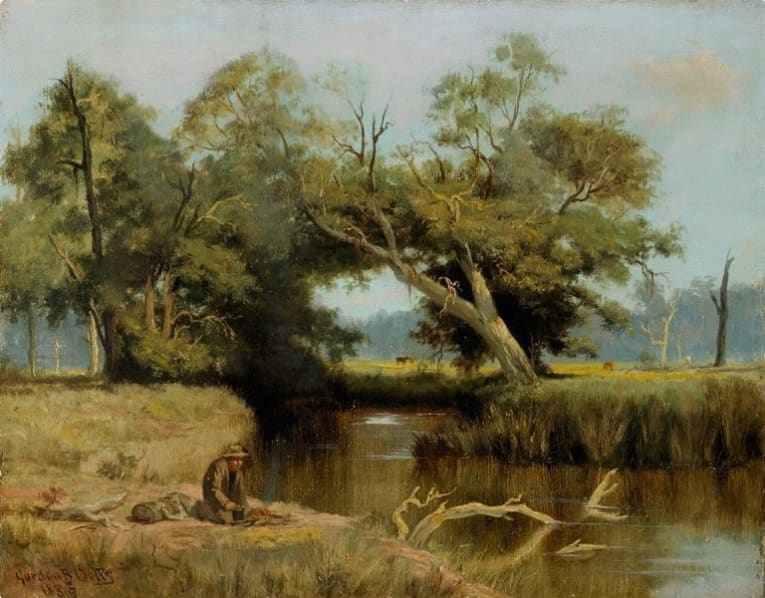
Lawson, a contemporary of Paterson, was less of humorist and more of a social commentator. Though he wrote a number of poems, he is better known for his short stories about Outback life, including A Day on a Selection (a selection was a tract of crown land for which annual fees were paid), and The Drover’s Wife.
Other balladeers include George Essex Evans, Will Ogilvie, Barcroft Boake and Barbara Baynton, who portrays the Outback as a cruel, uncompromising environment, without the romantic imagery of the bush.
The Outback proved a source of inspiration for a number of Australian novelists through the twentieth century. Xavier Herbert’s Capricornia (1938) and Poor Fellow My Country (1975) offer sweeping epics of Outback life, while Australia’s only Nobel prize-winner, Patrick White, drew on Outback settings in Voss (1957), The Tree of Man (1955) and The Aunt’s Story (1947). In the 1950s, Nevil Shute’s A Town Like Alice (1950) caught the imagination of readers around the world. Mary Durack’s non-fiction Kings in Grass Castles (1959) and Sons in the Saddle (1983) depict the white settlement of the Kimberley by her ancestors, ‘Cattle Kings’ who mustered cattle from Cooper Creek to the Kimberley on a 28-month trek from 1883 to 1885. The Outback also inspired international authors, including D.H. Lawrence, whose Kangaroo (1923) includes terrifying imagery of the Australian bush.
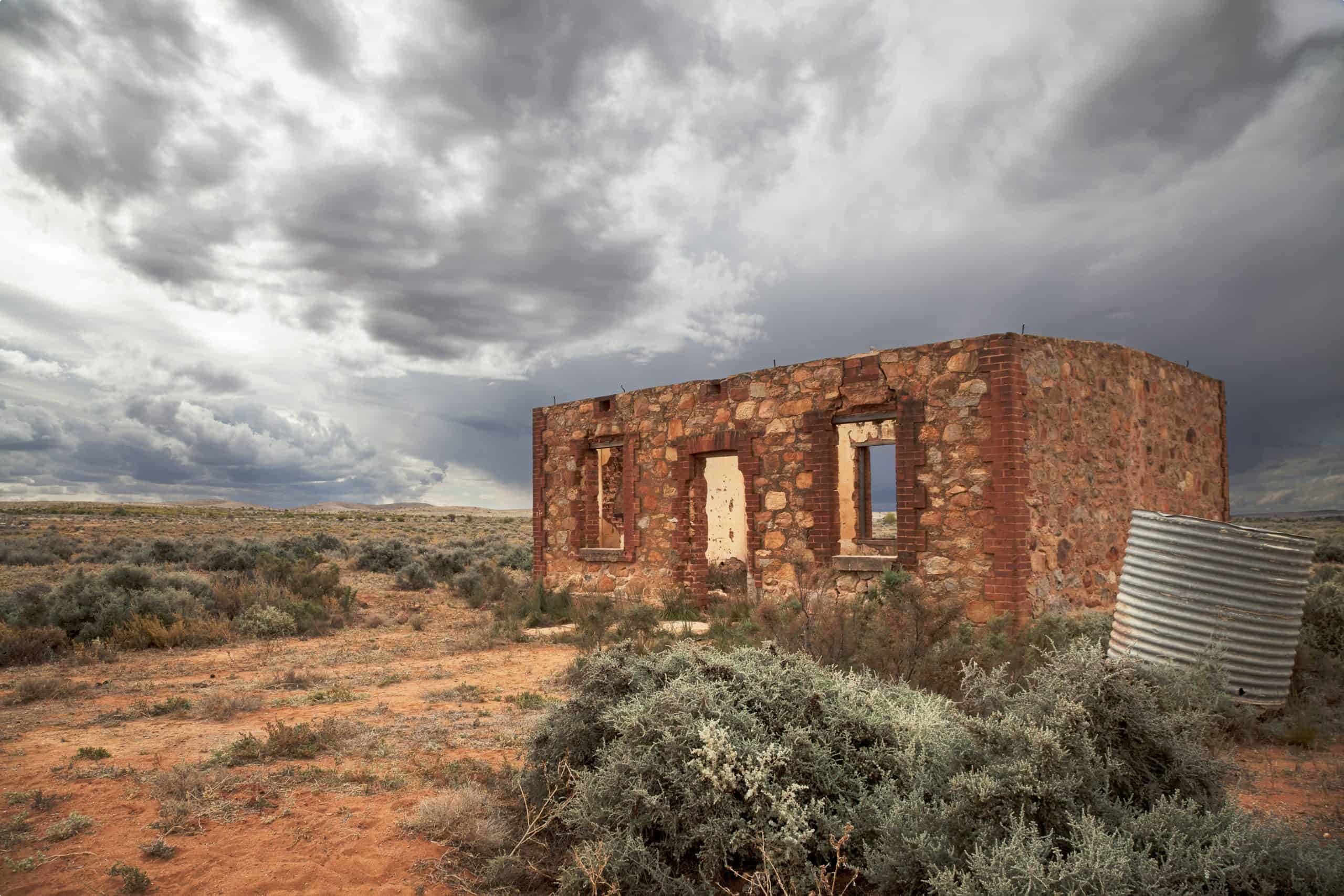
For most people, their introduction to Australia‘s Outback comes from the many films which use it as a setting. The first Australian colour film to show the Outback was Jedda (1952), the story of an Aboriginal girl, filmed at Katherine Gorge, Northern Territory. In the 1970s, acclaimed films such as Walkabout (1971) and The Chant of Jimmy Blacksmith (1978) told the stories of Aboriginal people in the Outback. The 1980s saw the Australian Outback featured in blockbuster pictures, including Crocodile Dundee and the Mad Max series. Beginning with Wake in Fright (1971), in which a Sydney schoolteacher is unable to leave the eerie town in which he is stranded, directors have drawn on the Australian Outback as a source of dread and horror.
Tour the Outback with Odyssey Traveller:
Odyssey Traveller now offers a number of outback Australia tours, including:
- Broken Hill and ‘back: This tour offers the ultimate Australian outback adventure, passing through the ‘corner country’ where
- Outback Queensland: Explore the quintessential outback of western Queensland, home to ancient Aboriginal sites, heritage pubs, and the Australian Age of Dinosaurs.
- Tour of the Kimberley: This outback tour takes you through the heart of the Kimberley, perhaps Australia‘s ultimate outback experience.
- Southern States of Australia: Visit UNESCO World Heritage sites and more on this tour of the outback and mallee regions of South Australia, Victoria, and New South Wales.
- Flinders Ranges: This Australian outback tour takes you through the stunning scenery of the Flinders Range and beyond to the remote towns of Coober Pedy and Oodnadatta.
- Wildflowers of Western Australia: While not devoted to the outback, the itinerary of this wildflower tour skirts the edges of Western Australia‘s ‘golden outback‘ to see desert flowers in bloom.
- Kakadu and Darwin: Tour of the majestic landscapes and ancient history of Kakadu National Park, in the Northern Territory’s ‘Top End’.
Every Odyssey guided tour is designed especially for mature and senior travellers, who seek an informed and educational travel experience. We move in small groups of around 6-12 per tour, and are led by an experienced tour operator/tour guide.
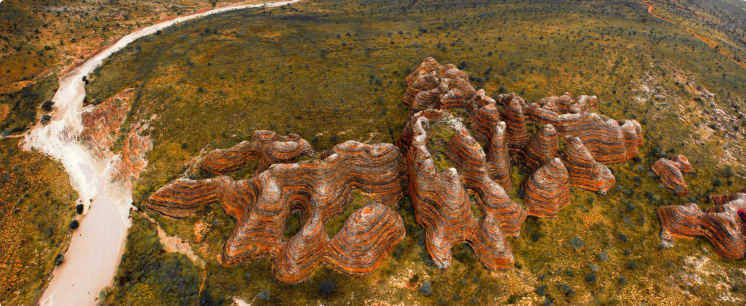
Articles about Australia published by Odyssey Traveller:
- The Kimberley: A Definitive Guide
- Uncovering the Ancient History of Aboriginal Australia
- Aboriginal Land Use in the Mallee
- Understanding Aboriginal Aquaculture
- Mallee and Mulga: Two Iconic and Typically Inland Australian Plant Communities (By Dr. Sandy Scott).
For all the articles Odyssey Traveller has published for mature aged and senior travellers, click through on this link.
External articles to assist you on your visit to Australia:
Small group package Tours of Australia
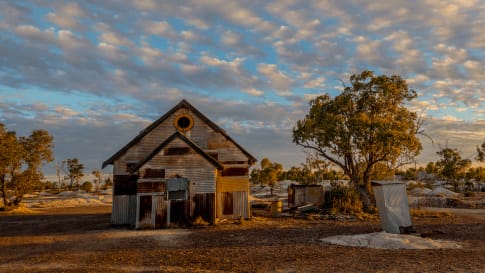
days
Mar, Apr, May, Jul, Aug +2Small group tour of outback Queensland
Visiting New South Wales, Queensland
To Dubbo and back, this small group tour takes you to learn about the Brewarrina fish traps, we travel high up into North Queensland to see the Dinosaurs of Winton and incredible Aboriginal rock art at Cathedral gorge and learn about opal mining and the history of Lightning ridge.

days
Mar, May, Aug, Sep, Oct +2Small group tour of World Heritage sites and more in the Southern States of Australia
Visiting New South Wales, South Australia
Discover the World Heritage Sites of the southern states of Australia travelling in a small group tour. A journey of learning around the southern edges of the Murray Darling basin and up to the upper southern part of this complex river basin north of Mildura. We start and end in Adelaide, stopping in Broken Hill, Mungo National Park and other significant locations.
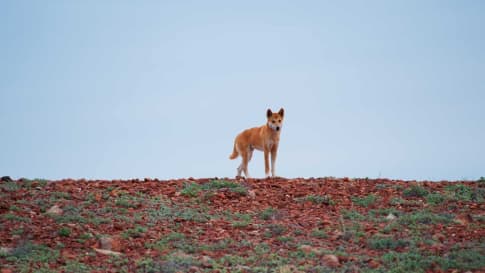
days
Apr, May, Jul, Aug, Oct +2Small group tour of Australia's Flinders ranges
Visiting South Australia
Escorted small group tour of the Flinders range in South Australia from Adelaide. Learn about Coober Pedy, Wilpena pound and water system of Lake Eyre as we explore and learn also about the history of the people who explored the Flinders.

13 days
May, Jun, Jul, Aug, SepSmall group tour of Australia's Kimberley
Visiting Western Australia
Escorted small group tour of the Kimberley. We explore and visit The Bungles, Bell Gorge, Mitchell plateau & Halls Creek in the dry season. Amazing landscapes intertwined with Aboriginal communities resident more than 45,000 years.
From A$15,390 AUD
View Tour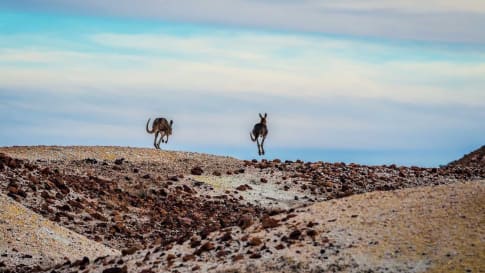
13 days
Mar, OctSmall group tour; Broken Hill and back
Visiting New South Wales, Queensland
Small group tour of New South Wales, Queensland & South Australia deserts, from Broken Hill. Learn about the history of the people who explored the deserts, from indigenous communities to Europeans, as well as Burke and Wills, visit White Cliffs, Birdsville, Maree.
From A$11,550 AUD
View Tour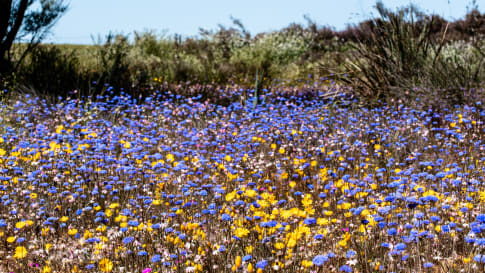
15 days
Aug, SepWildflowers tour of Western Australia
Visiting Western Australia
Escorted small group tour for senior and mature travellers as a couple of solo traveller. Upto 12 people of WA's Wildflower regions including Esperance and the Fitzgerald river National park. Local guides and program leader share knowledge about this fascinating region whilst in bloom.
From A$12,250 AUD
View TourArticles about Australia

Aboriginal culture of the Flinders Ranges, South Australia
The iconic Flinders Ranges of South Australia have a rich Aboriginal heritage and are home to a number of vitally important cultural sites and ancient artworks that this small group tour for mature and senior travellers has the opportunity its to learn about.

Aboriginal land use in the Mallee
Learning about the Mallee for a escorted small group tour of South Australia and Western Australia for mature and senior travellers. Understand the Mallee & Wildflowers relationship and the indigenous community land use.

Aboriginal Rock Art in the Kimberley, Australia
The Kimberley is explored on a small group tour for mature and senior travelers, couples or singles. Both Aboriginal community is studied and an appreciation of the wet and dry seasons. This guide on the Kimberley assists the traveler as you start from Broome and travel round via Halls creek and Purnunulu national park over some 17 days in a group of up to 12 people.

Aboriginal Sites of Importance in Outback Queensland, Australia
Outback Queensland is hiding a number of unforgettable indigenous experiences on this small group tour for senior travellers. Especially at the Brewarrina Fish Traps, and Carnarvon Gorge, for example where you can experience and learn about dreamtime creation stories, age-old cultural practices and traditions, and Aboriginal art.

Australia’s Ocean Frontier: Exploring the Eyre Peninsula, South Australia
Learn about the landscape and the recent settlement of this Peninsula on the South Australian coast. To see and learn more join on the this collection of Australian small group package tours for mature and senior travellers, couples or singles or join the Eyre & York peninsula program.
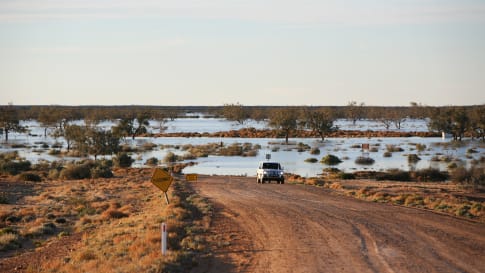
Birdsville and the Birdsville Track, Queensland
An icon of the Australian Outback. See and learn about the history of the outback both British settlement and aboriginal history out in the heat of the Australian desert! Small group package tours for mature and senior travellers couples for singles show you this often harsh environment full of stories.

Broken Hill, New South Wales
Broken Hill, is the start and finish of a 4k km exploration of the Deserts of the outback, the history, the aboriginal communities who manage them today. Broken hill small group tour for seniors is an iconic place to commence for active couples or solo travellers seeking to learn and explore.

Burra, South Australia
Once the 5th largest town in Australia, (the 1840's) this article is about the copper mining boom that was at Burra, and also the Yorke Peninsula. Mining boom also occurred at Broken hill with the wealth heading to Adelaide and Melbourne. Learn more on a small group package tour for mature and senior travellers couples or singles that includes Burra or one of the Australian tours offered.

Coober Pedy, South Australia
The town of Coober Pedy was established in 1915, when a 14-year old boy found a precious opal in a remote part of the South Australian outback. On this small group tour of the Flinders ranges we explore and learn about this and other towns in the Flinders and its importance to the Aboriginal community.

Expeditions of John McDouall Stuart in the Flinders.
John Stuart was an explorer who mapped the Flinders ranges as well as a path through the centre of Australia. The principal road from Port Augusta to Darwin is the Stuart Highway. The Small group tour of the Flinders ranges spends time learning about Stuart.

Flinders Ranges National Parks, South Australia
Rugged mountains, tree-lined gorges, an abundance of wildlife, and important Aboriginal works : the national parks of the iconic Flinders Ranges including Wilpena pound are the beginning of Australia's outback that we explore on a small group tour for mature travellers.

Halls Creek, Western Australia
Halls Creek an important stop on our Small group tour of the Kimberley. We learn about the gold rush on this tour for mature and senior travellers, couples and singles.
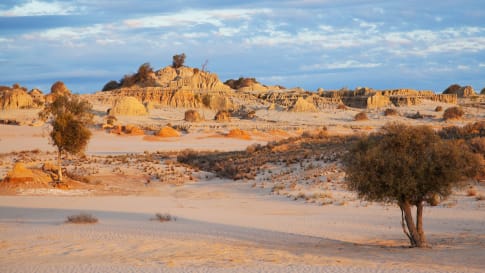
Mungo Man and Mungo Lady, New South Wales
Part of a small group tour of World heritage sites on Victoria, NSW & South Australia for mature and senior travellers. Learn and explore in the Mungo National park about Aboriginal settlement and the fauna and flora of this National park.

Oodnadatta, South Australia
Oodnadatta is an adaptation of an Arrernte word utnadata meaning 'blossom of the malga'. This town was part of a network of Aboriginal trading routes existing for tens of thousands of years. Learn and discover more on a small group tour of the Flinders ranges.
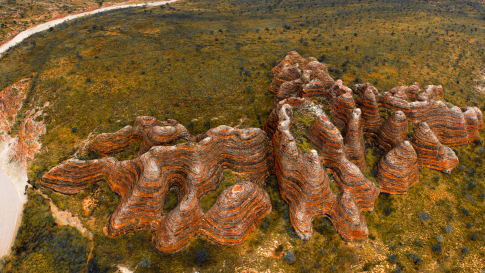
Purnululu National Park, Australia
Read about one of the most remote World heritage sites on Earth. Odyssey takes you to visit as part of a small group package tour for mature and senior travellers in the Kimberley for couple and single travelers We travel in the dry season from Broome via Lake Argyle to this National park.

The Burke and Wills Expedition, 1860-61
Learn on a small group tour of central Australia for active mature or senior travellers from Broken hill about Burke and Wills ambitious expedition. Suitable for mature aged couples or solo travellers.

Winton and Dinosaurs, Queensland
Small group tour for senior and mature travellers to Outback Queensland includes Winton and its Dinosaurs as well as Longreach, Cathedral Gorge and Aboriginal art, & Barcaldine.



